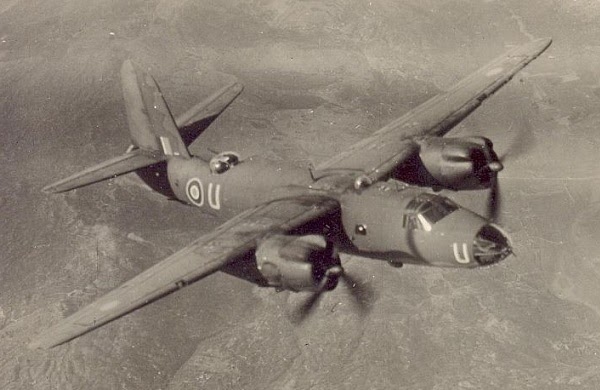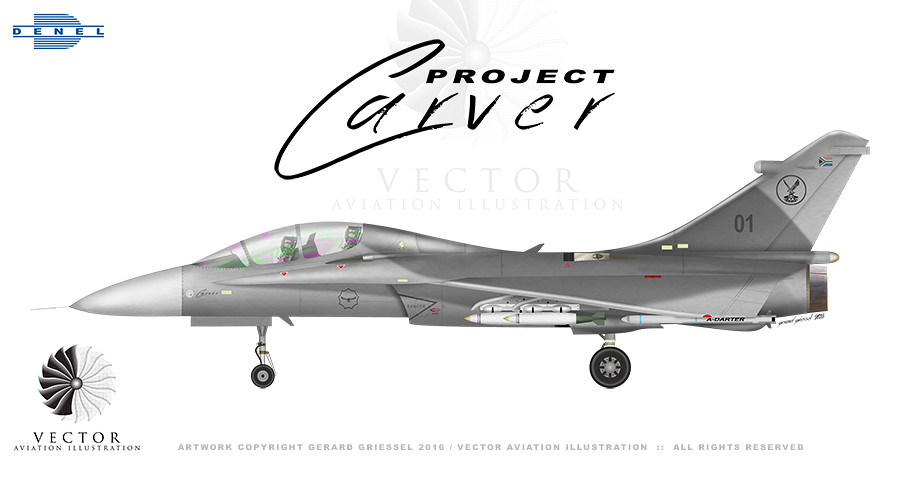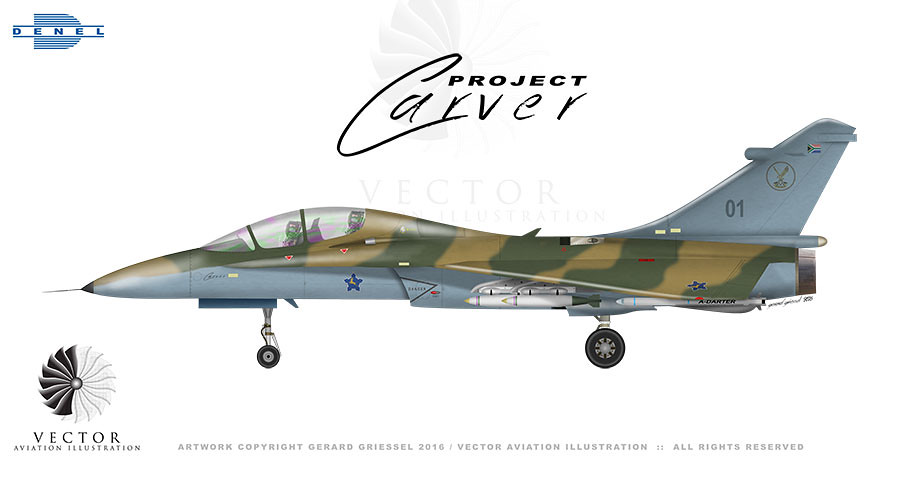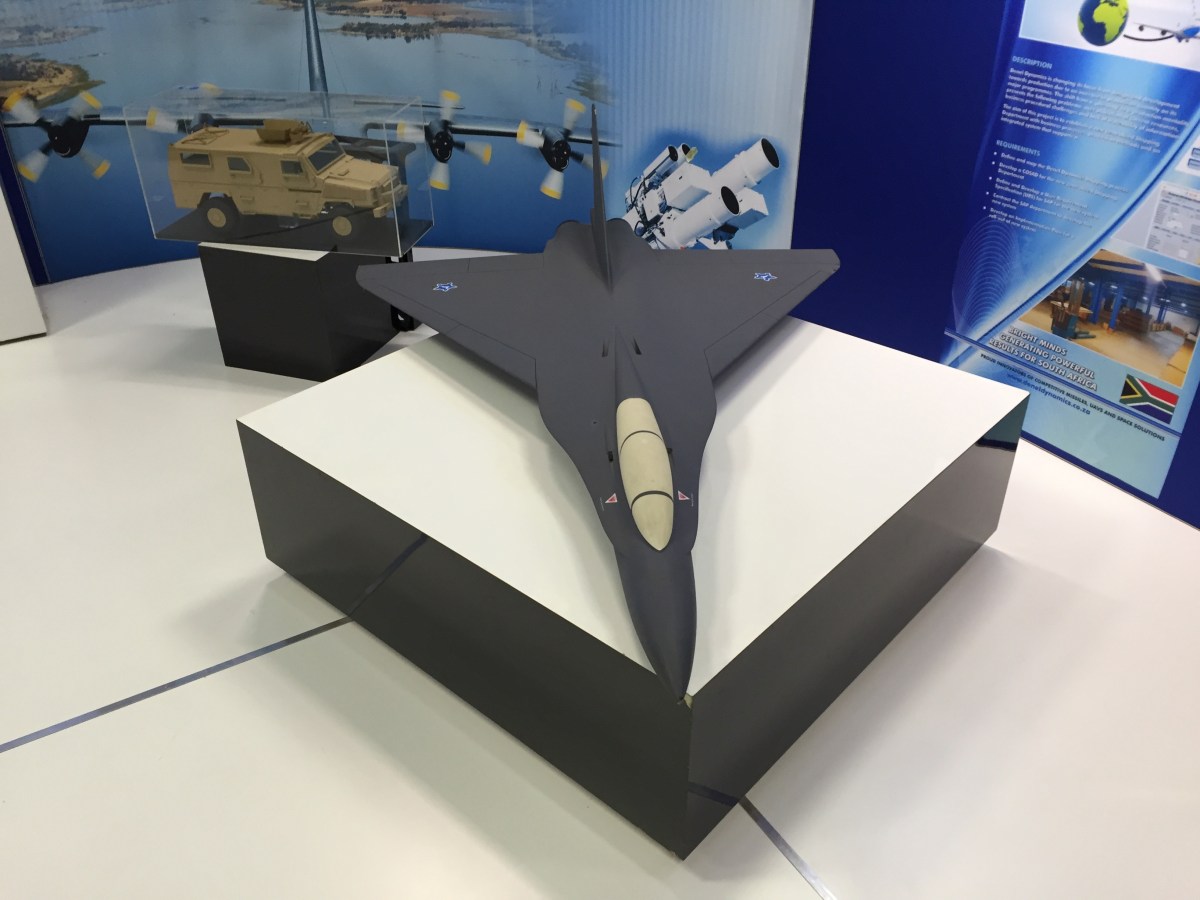Project Carver emerges from the shadows
by Darren Olivier | Nov 14, 2016 | Featured, Southern Africa | 0 Comments
Project Carver emerges from the shadows
This article was originally published in the May 2016 edition of FlightCom magazine. It has been lightly edited for republication here.
Denel’s stand at the Rand Show held earlier this year featured an unexpected surprise: It was the first time ever that a twin-engined model of South Africa’s highly-classified indigenous jet fighter programme of the 1980s had been shown in public.
This programme, called Project Carver, was an ambitious attempt to design and build a fourth generation fighter aircraft that could replace the aging Mirages and Buccaneers in South African Air Force (SAAF) service and match or exceed the later-generation Soviet-built aircraft that were entering service or predicted to enter service in neighbouring countries, specifically Angola, where the Border War was still raging.
By 1991, Carver had been cancelled, as the simultaneous end of the Cold War, the Angolan Border War and the looming end of Apartheid, and with it the international arms embargo, meant it was no longer needed. However, it remains one of the most fascinating technological programmes ever undertaken in South Africa. While the vast majority of information on Carver remains classified, this article is an attempt to describe the programme and its context as comprehensively as possible from the few public sources that have emerged.
The legacy of Carver can be seen everywhere in the South African aerospace industry, but it came at significant financial cost. By 1991 the country had spent US$2 billion on it, equating to over R54 billion in today’s money, without a single aircraft to show for it.
BIRTH OF THE PROJECT
Project Carver began in the early 1980s, when the South African Air Force initiated a series of project studies to determine the options for new or upgraded fighter aircraft. They needed to regain the upper hand in Angola, where the SAAF’s Mirage IIIs and Mirage F1s were unable to match the performance of the MiG-23s in service with the Angolan and Cuban air forces, and to ensure South Africa’s aerial superiority in the region for the next two decades.
Three concurrent programmes emerged from this process, with different time scales. The first, Project Brahman, started in 1983 and was a Mirage III upgrade to be done in conjunction with Israel. It resulted in the Cheetah Ds and Cheetah Es.
Project Carver was the second, a 1985 programme to design and build an advanced New Generation Fighter Aircraft System that would be able to replace all the aircraft in SAAF service from the year 2000 and match or exceed the performance of even later generation Soviet-built aircraft that were predicted to enter service in Southern Africa.
The third was Project Tunny, which had its roots in a project study from 1985 for an interim fighter that would bridge the gap between the retirement of the Mirage F1CZs and Cheetah Es and the arrival of the Carver aircraft. In 1988 it became an official project for the procurement of what would become the Cheetah C.
The requirements for the New Generation Fighter Aircraft System, for which Carver was established, were bold and demanding. The SAAF wanted an aircraft that was broadly in the same class, in terms of avionics and performance, as an F-16 or Mirage 2000. But this would have to be achieved at the height of sanctions, meaning that few components or systems could be acquired from outside the country. The only readily available engine option was the Snecma Atar 09K50 turbojet, which was used in the Mirage F1 and was heavier and less powerful than more modern turbofan engines.
According to the Carver Project Officer, as quoted anonymously in Winston Brent’s book ‘Cheetah: Guardians of the Nation’, it was estimated that over 4,000 engineers alone would have been required at the peak of the development phase, which would have lasted for about six years. The cost and development times were expected to be significant, owing to the effects of sanctions and the need to develop much of the technology locally.
To figure out how to make this happen, the Carver project team set about drafting the project’s User Requirement Specification (URS). A typical URS is a comprehensive document that’s prepared for any major SAAF procurement. It builds on the Staff Target and Staff Requirement to lay out in painstaking detail every requirement of the system being acquired. This includes not only the basic performance of the aircraft, but what roles it must perform, the capabilities and man-machine interfaces of its onboard systems, its maintenance needs and a full integrated logistics support plan. For instance, the URS for Project Ukhozi, under which the Gripens were acquired, ran to dozens of pages packed with detail.
However, the Carver URS was more difficult than most and took 15 months to draft because, according to the Project Officer, much time had to be spent on testing and re-testing the validity of the requirements and analysing whether local industry would be capable of meeting those needs. What emerged was no less than the biggest technological development programme in South African aerospace history.
A model of the twin-engined Project Carver concept, seen at the 2016 Rand Show
A model of the twin-engined Project Carver concept, seen at the 2016 Rand Show
STARTING FROM NOTHING
As South Africa had no experience with designing fighter aircraft, Atlas Aircraft Corporation (which was appointed as the prime contractor) began to recruit aircraft designers from around the world. One of those was David Fabish who, having worked on the Mirage 2000 at Dassault, was appointed as the lead designer on Carver.
In the initial design phase, many variations were explored for the aircraft, but by 1986 Atlas had settled on a light single- engined design 16 metres in length with a wingspan of about 9 metres, a single vertical stabiliser and a mid-mounted delta wing with F/A-18-style leading-edge root extensions (LERX) above curved side engine intakes. The design featured extensive use of composite materials, both to reduce weight and reduce the radar signature. It was to be able to carry all the weapons then in the SAAF’s inventory or in development at the time, including the H-2 guided bomb, V3C and U-Darter short-range guided missiles and the planned beyond visual range missile that later entered service as the R-Darter. Its payload capacity would have been comparable to that of a Mirage 2000.
Yet little of the technology required to build the aircraft existed locally, so Atlas and the SAAF began spending huge amounts of money in focused research and development in three main areas: high- strength composite materials, integrated digital avionics and communications systems, and jet engine development.
Much of the latter research went into Mattek and Aerotek’s work to increase the performance and reliability of the Atar 09K50 engine, by refitting the turbine with single-crystal blades and replacing the riveted compressor with a welded one.
This resulted in a 10% performance boost, greater reliability and much more carefree throttle handling in all flight conditions. However, even with this improvement, the 09K50 remained too heavy and too low-powered for Carver to meet its performance requirements, a problem which was never fully solved. Atlas attempted to covertly acquire Snecma M53s (as used in the Mirage 2000) and Snecma M88s (as used in the Rafale and the planned Novi Avion), but neither attempt came to fruition.
By 1987, the project was going forward at full pace and, when the Israeli Aircraft Industries Lavi was cancelled, Atlas went on a recruiting spree amongst the engineers who had worked on it, offering fantastic incentives such as salaries starting at US$7,000 a month paid in any currency into any bank account in the world, free accommodation and regular free or heavily-discounted flights back to Israel. Unsurprisingly, a few hundred engineers and designers accepted the offer and joined Atlas and the Carver project.
The project soon progressed to the testing of scale models in the Council for Scientific and Industrial Research’s (CSIR) wind tunnels, some of which had been built especially for the project.
By 1988, construction on some full-scale elements had begun, in the lead-up to a 1:1 scale mock-up and later a prototype. One photo shows the Carver design team standing in front of a jig with a machined frame section from the aircraft’s midsection, where the main landing gear would have been fitted.
A model of the twin-engined Project Carver concept, seen at the 2016 Rand Show
A model of the twin-engined Project Carver concept, seen at the 2016 Rand Show
CHANGE TO A TWIN
However, the project was thrown into disarray that same year when the SAAF made the decision to scrap the single- engined variant and to change the design to a twin-engined aircraft instead. The specific reasons for this remain unclear, but two main explanations have been submitted by those who worked on the project: The first was that even with the 10% performance increase that Mattek and Aerotek had managed to achieve with the Atar 09K50, the engine remained too heavy and too low-powered for Carver to meet its performance requirements, thus the decision to switch to a twin-engined configuration. The second was that the new Chief of the SAAF, Lt Gen. Jan van Loggerenberg, had flown Buccaneers and wanted an aircraft with a similar range and load-carrying capability.
Whatever the actual reason for the change in configuration, it set the project back by at least two years, as the use of two engines required a much larger and heavier aircraft — closer to the size of the Mirage 4000 – with more complex systems. This forced the design team to return to the drawing board.
The model shown in the accompanying pictures was the one built to showcase that twin-engine configuration. The Dassault influence in the design is obvious.
That delay, along with others, made the SAAF realise that Carver would no longer be ready in the timescales originally planned for, so in 1988 it approved the interim fighter project, Tunny, to acquire an aircraft that could fulfil the country’s air defence needs to around 2008-2012. The 38 Cheetah Cs that were developed under this project were delivered from 1993 to 1994.
CANCELLATION
In the end, the delays were the project’s death knell, as external circumstances changed and the project’s rationale began to fade away. The Angolan Border War, once the driver for the development of South Africa’s military capabilities, ended in December 1988 with a peace deal. The Soviet Union collapsed in 1990 and by 1991 it was clear that South Africa was on its way to a negotiated transition and the end of Apartheid, after which the arms embargo would be lifted. In the context of these developments, it no longer made sense to continue spending so much on developing an indigenous fighter and in February 1991 President FW de Klerk announced the cancellation of Project Carver.
The legacy of Carver can be seen everywhere in the South African aerospace industry, but it came at significant financial cost. By 1991 the country had spent US$2 billion on it, equating to over R54 billion in today’s money, without a single aircraft to show for it. On top of that, the acquisition of the Cheetah Cs as interim fighters had cost another US$1.8 billion or R43 billion in today’s money. To put this in context, the entirety of the controversial 1998 Strategic Defence Procurement Package, popularly known as the ‘Arms Deal’, cost US$4.8 billion for 26 Gripens, 24 Hawks, 30 A109s, 4 Valour-class frigates and 3 Warrior-class submarines.
Yet even with the knowledge that a production run of Carver aircraft would have cost another US$2 billion or so, it’s impossible to shake the wish that the timing had worked out a little more in its favour and that a prototype had flown. It would undoubtedly have pushed the local defence industry to another level of sophistication and might have created more sales and development opportunities after 1994.

 Carver_small by Gerard Griessel, on Flickr
Carver_small by Gerard Griessel, on Flickr Carver2_small by Gerard Griessel, on Flickr
Carver2_small by Gerard Griessel, on FlickrCarver_small by Gerard Griessel, on Flickr
Carver2_small by Gerard Griessel, on Flickr

